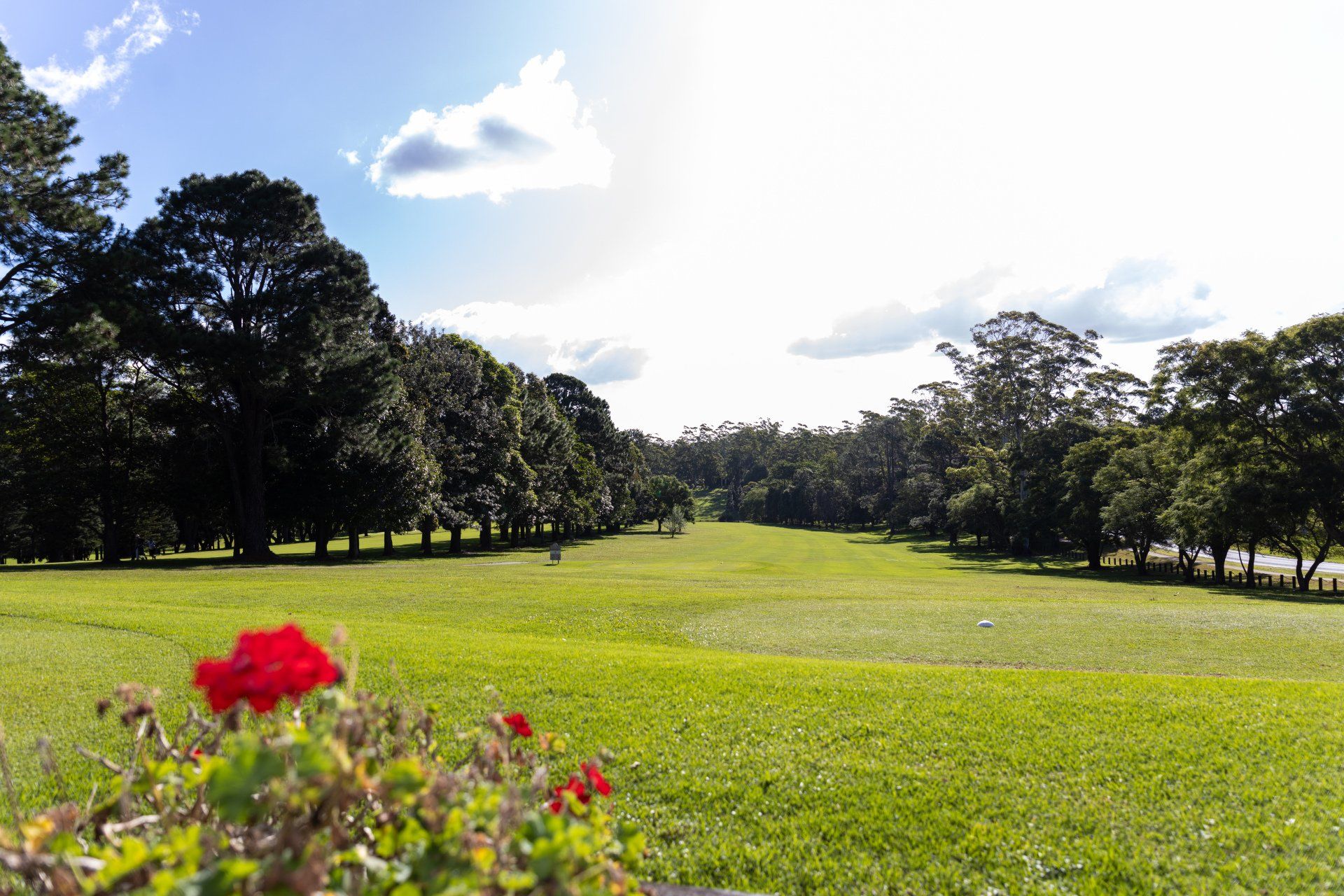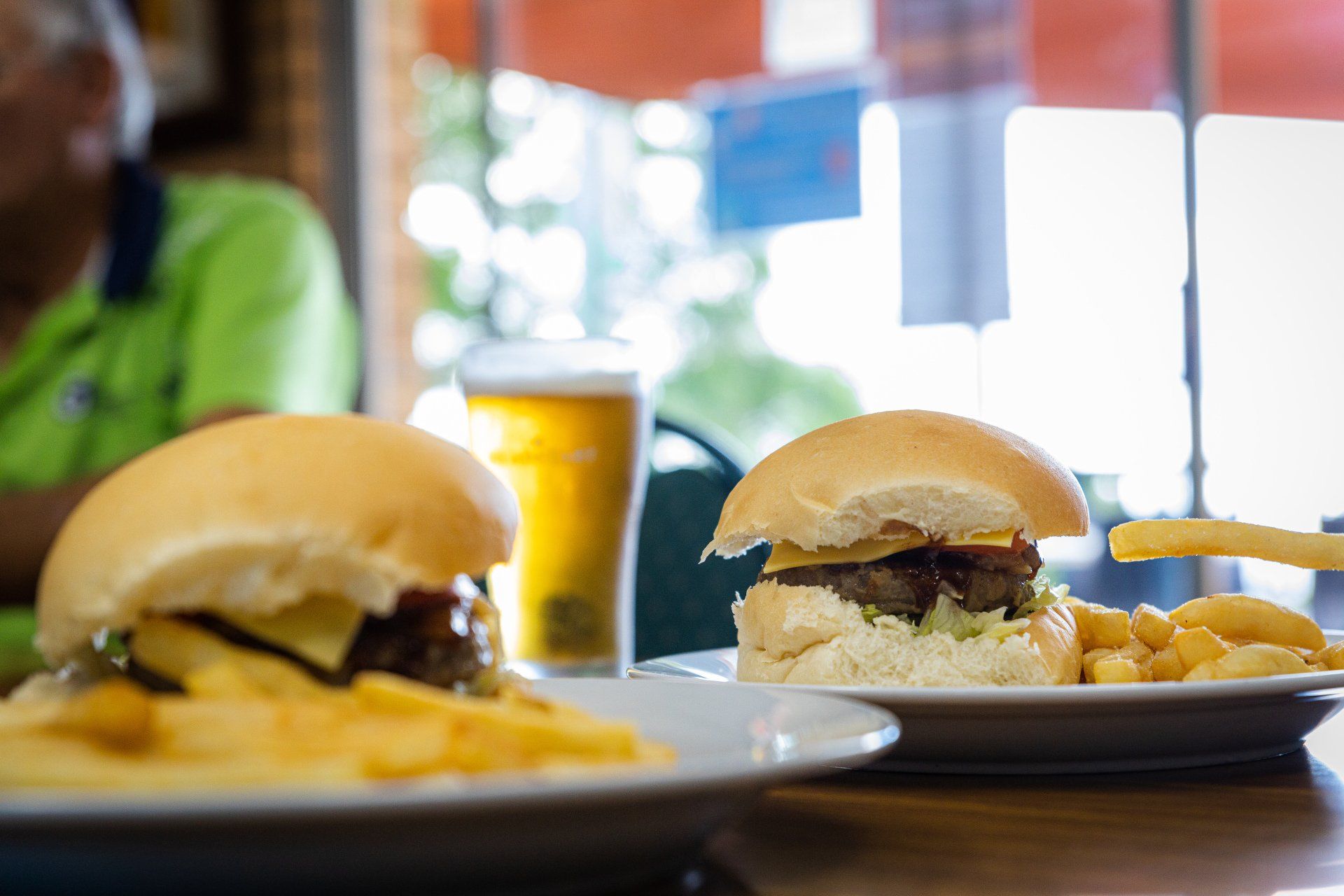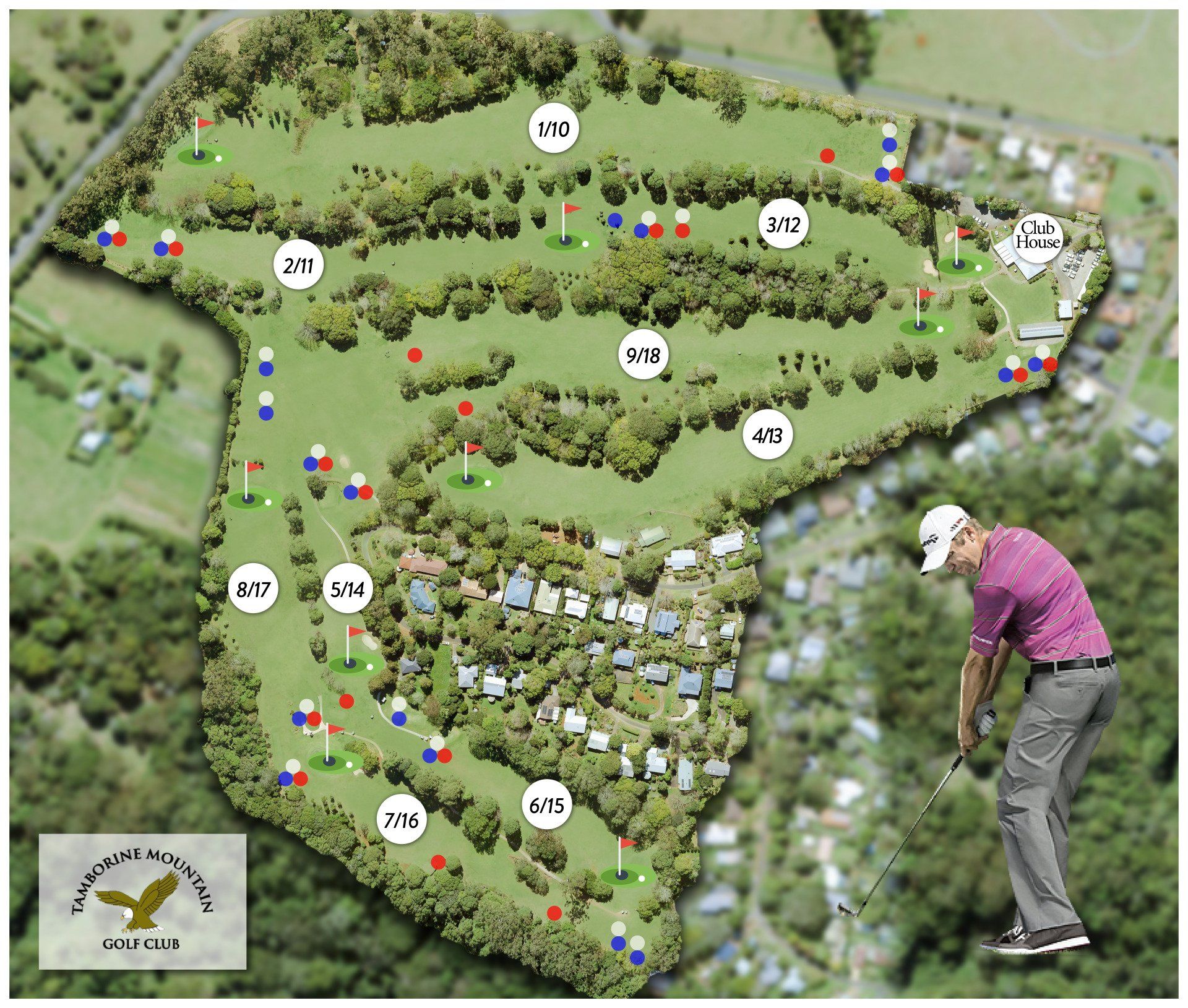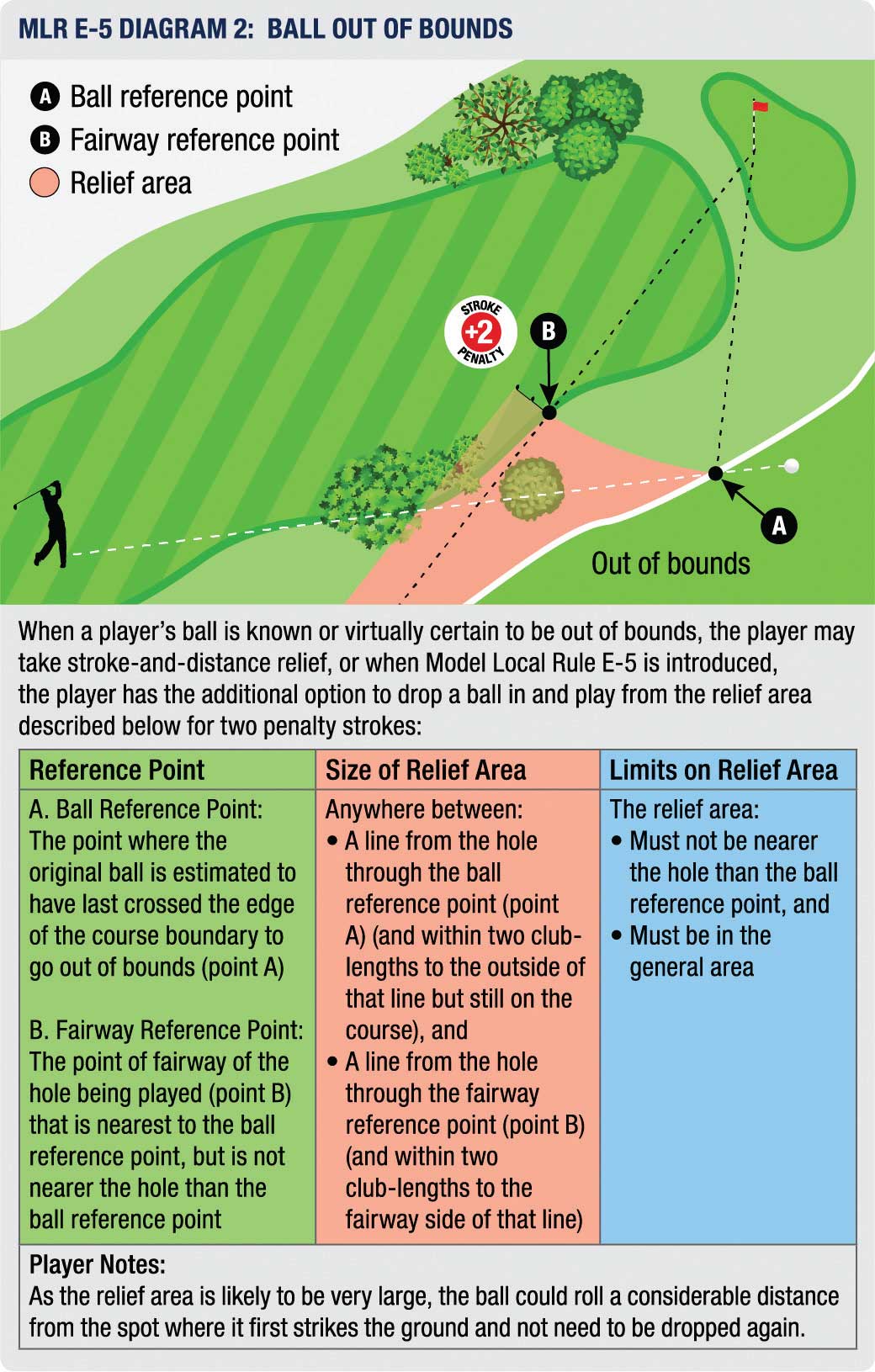Amazing location - Situated 500m above sea level, overlooking the Gold Coast, this acclaimed 9 hole, 18 tee golf course is a delight to play any time of the year.
Unlike the coastal courses we don’t flood in the wet season, always several degrees cooler with minimal humidity during summer.
Course Layout
9 holes, 18 tees, par 70, length 5,562m
Tamborine Mountan Golf Club is situated 500m above sea level overlooking the Gold Coast and the Stradbroke Islands. Its proximity to the Gold Coast, the fantastic views and it’s own stunning hinterland environment, makes it one of the most unique golfing locations in SE Queensland.
Tamborine Mountain Golf Club’s layout is very “playable” for all level of golfers. It has 3 teeing areas to provide an enjoyable round for beginners or elderly golfers, yet when played off the blue tees provides a challenge for those looking to test their skills with nature and the raft of elevated bent grass greens.
Local Rules
To be read in conjunction with the Rules of Golf.

Out of Bounds (Rule 18.2)
- All areas beyond the boundary fence posts or lines of white stakes with black tops are out of bounds. In the area from the clubhouse to the first tee, the boundary is the inside edge of the pathway between the white stakes with black tops. For the ball to be out of Bounds, the entire ball needs to be outside the inside line of the reference posts.
- When a player’s ball is known or virtually certain to be out of bounds, the player may proceed under the Local Rule for a penalty of two strokes, rather than proceeding under stroke and distance. This Local Rule is not available if a provisional ball has been played.
See Model Local Rule E-5 Diagram 2 (TMGC Program booklet or diagram sheet on local rules board) for full details of the Local Rule.
Ball not Found
- When a player’s ball has not been found, the player may proceed under the Local Rule for a penalty of two strokes, rather than proceeding under stroke and distance.
This Local Rule is not available if a provisional ball has been played. See Model Local Rule E-5 Diagram 1 (TMGC Program booklet or diagram sheet on local rules board) for full details of the Local Rule.
Abnormal Course Conditions and Ground Under Repair (Rule 16)
Trees (including tree stumps) identified by white stakes are no play zones:
- If a player’s ball lies anywhere on the course other than in a penalty area and touches such a tree or such a tree interferes with the player’s stance or area of intended swing, the player must take relief under Rule 16.1f.
- Ground under repair is defined by any area encircled by a painted white line. Relief may be taken under rule 16.1a.
- Ground under repair includes exposed rocks or tree roots in areas cut to fairway height or less. Even if not circled by a white line relief may be taken 16.1b.
Integral Objects
- Retaining walls, sand bins, shelter sheds, ball washers, rubbish bins and bench seats are integral objects. These are to be treated as immovable obstructions. Relief is to be taken under rule 16.1a.
Immovable Obstructions Close to Putting Green
- In addition to the types of interference described in Rule 16.1a, when a ball lies in the general area, interference also exists if an immovable obstruction (i.e. a fixed sprinkler heads) is on the player’s line of play, is within two club-lengths of the putting green, and is within two club-lengths of the ball. The player may take relief under Rule 16.1b. (Exception – There is no relief under this Local Rule if the player chooses a line of play that is clearly unreasonable.)
Ant Hills and Paths
- Large or hard ant hills on the course are, at the player’s option, loose impediments that may be removed under Rule 15.1a.
- All paths on the course, even if not artificially-surfaced, are treated as immovable obstructions from which free relief is allowed under Rule 16.1.
Suspension of Play
- A suspension of play for a dangerous situation will be signalled by air horn. All other suspensions will also be signalled by air horn. In either case, resumption of play will be signalled by the same air horn. See Rule 5.7b.
Slow Play
- If a group finishes the round two (2) full holes more behind the group in front or in more than 4hrs and 15 minutes from the time of starting, all players in the group may be subject to a penalty of one stroke.
Garden beds are part of the course and the ball should be played as it lies, or take a one stroke penalty as an ‘unplayable’ – Please read Rule 16; Ball Unplayable for the options.
Uncertain of a Situation in Play? A second ball may be played and advice about the correct procedure
MUST be obtained as soon as possible and before the card is signed and handed in.
Knowing the rules (Rule 1) Players and their caddies are responsible for know
Match Committee
Dangerous & Unplayable Playing Conditions
Course Evacuation Plan and Suspension of Play
A. Responsibilities
- Management
The management committee has a responsibility to do everything possible to protect members and visitors, as far as it is able, and to manage the various situations that might arise. The delegated responsibility rests in the hands of the match committee consisting of Captain, Vice-Captain and Professional. The Professional is more likely to be on course and may make the appropriate decision in the absence of, and on behalf of the Captain and Vice-Captain. - Players
Players themselves must also take measures to ensure their safety. Players in a competition may stop playing if they think that weather conditions threaten them, even though the match committee might not have authorised a stoppage.
Without exception, once the warning hooter is sounded, each player must cease play, may mark the ball or leave it as it lies, and move quickly to the clubhouse, or another safe location, and remain there until play is resumed, generally by sounding the warning horn.
B. Dangerous conditions
- Lightning
Lightning is unpredictable and poses a risk and sometimes strikes even if the cloud or rain are as distant as 16 kilometres away. If the match committee is aware that lightning is approaching, it will suspend play before the storm is predicted to arrive to give players time to return to the clubhouse. To commence the evacuation procedure, a warning hooter will be sounded and the Professional or his staff will drive around the course to ensure that all players hear the warning. As well, the Professional may assist some players, especially from farther parts of the course, to return to the clubhouse.
The threat of lightning continues for some time after the last clap of thunder so play should not be resumed for at least 30 minutes thereafter. - Poor visibility due to mist or fog
A particular issue on Tamborine Mountain is the presence of low cloud or mist that may obscure the visibility in front of players, such that it may become unsafe for players in front should a ball be played in their direction. The match committee will not let players start play if conditions pose a safety threat to players in front and may also call the cessation of play if poor visibility develops during play.
It is the responsibility of players that, during play, if they cannot see clearly to the distance that they would normally hit that shot, plus a safety margin, then no shot should be played until visibility improves sufficiently.
C. Procedure for ceasing play
Players may cease playing at any stage and, if a hole has not been completed, a player may mark the ball and lift it, or alternatively may leave the ball as it lies, and then make their way to the clubhouse.
If lightning is the cause, players should spread out from other players and avoid moving past and sheltering under tall objects such as trees and poles and in the shelter shed at the 6th tee. If caught in the open with lightning around, players should squat down, tuck their heads in and cover their ears and move to the safest place as soon as the immediate threat passes. Note that a raised umbrella can increase the chance of being struck by lightning as it increases the effective height of the player.
D. Resumption of play
The match committee will inform players of the procedure for the resumption of play. Usually a PA announcement will be made and a hooter may be sounded.
If the exact position of the original ball cannot be determined, e.g. because it or the ball marker has moved during the suspension, the position must be estimated and a ball placed on the estimated spot.
E. Effects on competition matches underway
Competitors do not have authority to determine that the course is unplayable for competition purposes.
- In stroke play
If the above adverse conditions apply, the match committee may suspend play which will resume from where play was discontinued or it may cancel the competition round which will be replayed at a future date. Where it would be grossly unfair not to cancel, for example, if some competitors begin a round under extremely adverse weather conditions, and conditions subsequently worsen such that further play that day is impossible, it would be unfair to the competitors who had started not to cancel the round. - In match play
But in match play, the competition cannot be cancelled and if the players in a match have completed for example six holes, they must resume play at the 7th tee. The match will not replayed.
F. Casual water
A competition will not be suspended solely because of heavy rain. But if the rain is so heavy that the course has become unplayable, or it would be unfair to require players to continue, for example, balls are moving frequently on the putting greens due to wind or running water, or holes are surrounded by casual water, the match committee may consider the course unplayable and suspend play. Should conditions improve, match committee members will inspect the more vulnerable parts of the course and may recommence play.
Our Sponsors
Tamborine Mountain Golf Club values the relationship it has with its partners who support our Club and its endeavours. Many are leaders in the club, their industry and the wider community.
If you would like to be involved with Tamborine Mountain Golf Club, and the opportunities associated with being a Corporate Partner please contact us. We have many tailored solutions sure to suit your needs.
USEFUL LINKS
CONTACT US
New paragraph

















